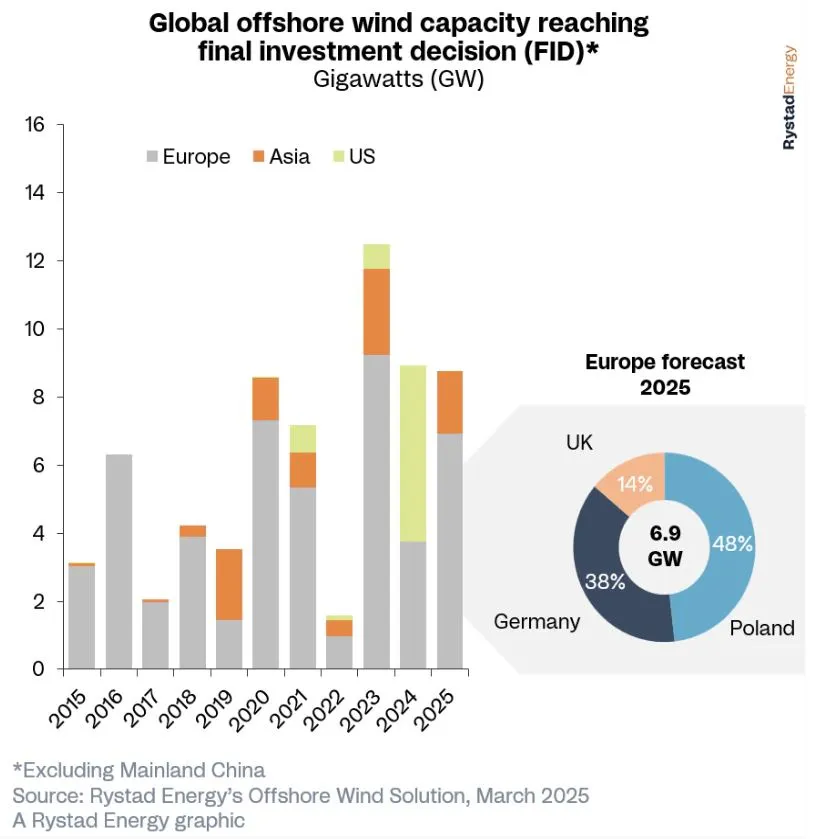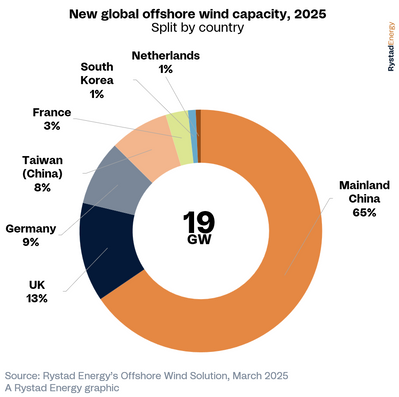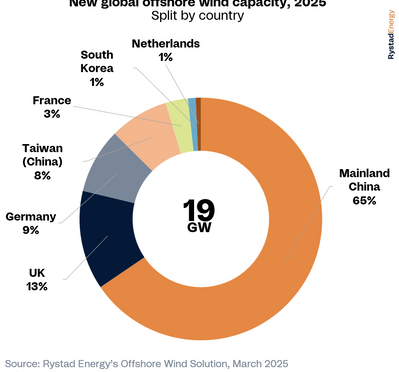Offshore wind power is expected to reach a historic milestone in 2025. According to Rystad Energy, the wind turbines coming online this year will total 19 GW.
China plays a central role in this growth. According to data, the country will account for 65% (12.35 GW) of the total estimated to come online. This progress reflects China’s commitment to expanding wind energy and reducing dependence on fossil fuels.
Furthermore, Chinese government investment and tax incentives are further driving the deployment of offshore wind farms. In this way, China is consolidating its position as a global leader in the sector, ensuring continued growth in clean energy.
While China will lead this expansion, the United Kingdom and Germany will also have significant stakes in increasing offshore wind capacity. These countries continue to invest heavily in infrastructure and new technologies to expand their sustainable energy mix. In the United Kingdom, the government has already announced plans to double installed capacity in the coming years. At the same time, Germany is pursuing its long-term strategy to achieve carbon neutrality by 2045. To this end, the country is investing in wind energy auctions that attract investors and encourage new projects in the North Sea.

With this growth, both countries seek to strengthen their position in the renewable energy market. At the same time, they are making a significant contribution to reducing global carbon emissions.
Despite the positive outlook, the offshore wind sector still faces significant challenges. Among the main obstacles, uncertainties related to leasing agreements between landowners and wind energy companies can directly affect the pace of new projects.

Furthermore, in 2024, 55 GW of offshore wind capacity was offered in leasing auctions (excluding mainland China). However, many of these events were underbid, highlighting a potential market slowdown in some regions. Another point of focus is the instability in the supply chain. As the production of essential components, such as blades and wind turbines, depends on a few global suppliers, any logistical problems could affect the delivery of new wind farms. Consequently, costs tend to rise and implementation times become less predictable.
Donald Trump’s arrival as president of the United States brought new uncertainties to the wind energy sector. Upon taking office on January 20, Trump declared a “state of emergency” in the sector and suspended offshore wind projects along the country’s coasts.
As a result, companies operating in this market are concerned about possible subsidy cuts and restrictions on the implementation of new projects. Still, some states, such as California and New York, have indicated they will continue to invest in wind energy even without federal support.
This divergence between state and federal policies could have different impacts on the growth of wind energy in the United States. While some regions continue to encourage investment, a lack of federal government support could limit the advancement of offshore wind energy in the US.
Despite the challenges, the offshore wind sector has made significant technological advances. Currently, more efficient and higher-capacity wind turbines increase the economic viability of projects. Furthermore, the use of artificial intelligence and sensors for preventive maintenance reduces operating costs and improves wind turbine efficiency.
At the same time, investors are showing growing interest in the sector. Infrastructure funds and large energy groups view offshore wind energy as a promising market for the coming years. Given the growing global demand for energy, financial contributions are likely to increase, consolidating this sector as one of the most strategic for the global energy transition.
The record growth forecast for 2025 signals a positive trend for offshore wind energy. With continued investment, technological advancements, and favorable public policies, the sector is expected to continue expanding in the coming years.
Furthermore, experts indicate that by 2030, global installed offshore wind energy capacity could exceed 300 GW. Wind energy thus consolidates its position as one of the world’s leading renewable sources, contributing to energy security and the decarbonization of the global economy.

